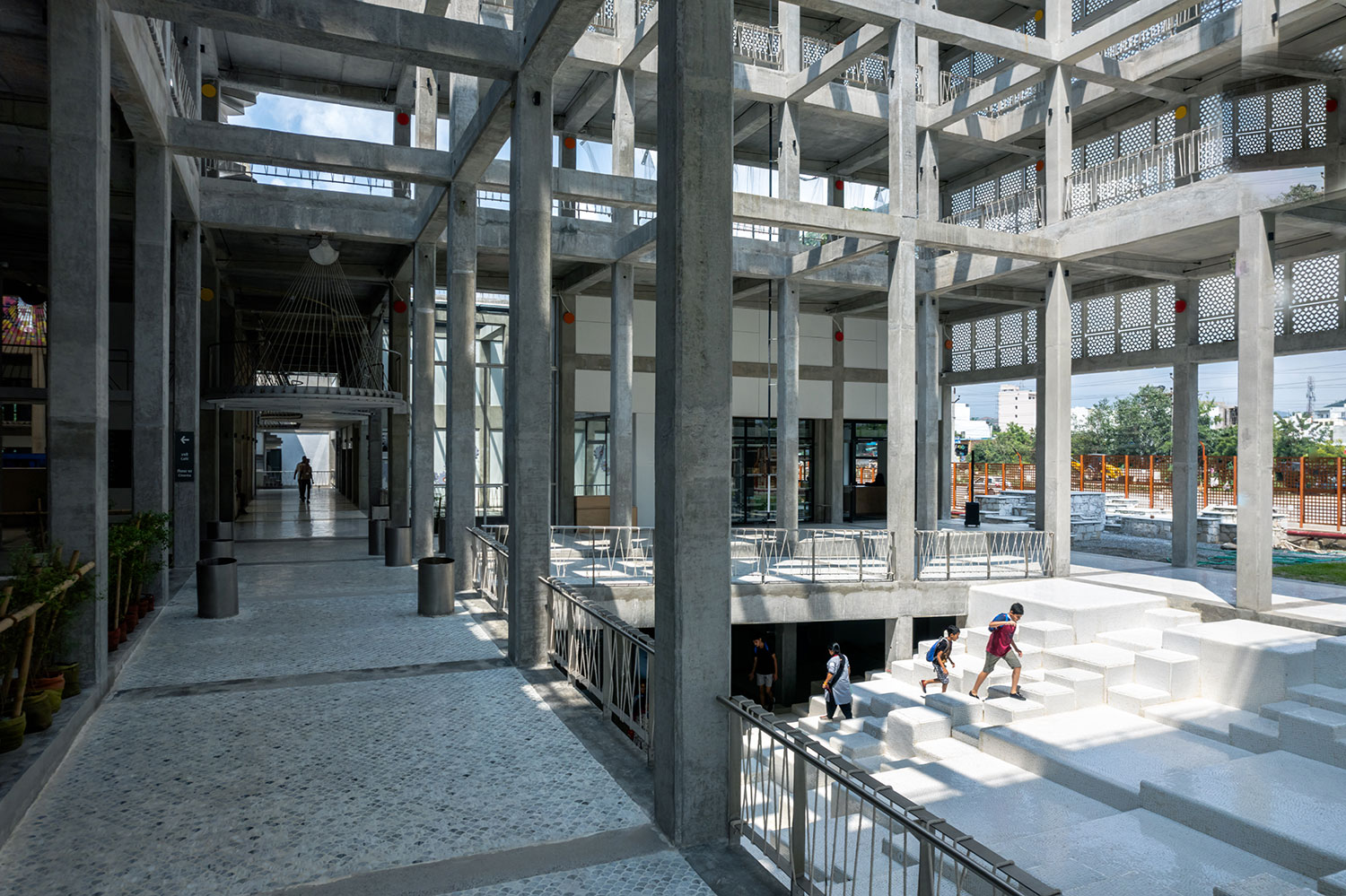In Udaipur, Rajasthan, Studio SAAR has designed a new learning and cultural centre for Dharohar, a not-for-profit organisation dedicated to providing extra-curricular activities for both adults and young people.
Photos
Ananya Singhal, Ankit Jain & Edmund Sumner
Envisioned as a ‘third space’ — a place beyond home or school — Studio SAAR’s design for the centre in Udaipur, northwest India, encourages local children and people of all ages to explore diverse, hands-on activities to better understand the world and their place within it. With a capacity to host up to 2,000 visitors a day, the centre provides a range of learning and cultural facilities including a library, cinema, multipurpose performing arts theatre, an interactive exhibition of science and technology, maker spaces, workshopping and co-working areas, as well as a library, a café and retail space.
The idea for such a centre began with plans for a learning hub focused on science, later developing into a facility that could cater for a wider audience.
Studio SAAR came into the project through a family connection of co-founder Ananya Singhal. The studio, which has offices in Frome in Somerset and Udaipur in India, is owned by a company Secure Meters Ltd, which is owned and managed by the Singhal family, who also manage Dharohar, the client for Third Space. (We sat down with Studio SAAR co-founders Ananya Singhal and Jonny Buckland to learn more about the young practice).
The activities and curriculum at Third Space are linked to an 80-hectare rewilding project by Dharohar and Studio SAAR, which aims to restore local flora and fauna to increase biodiversity. This integration provides further learning opportunities, connecting the community with the local ecosystem that sustains it.
Inside, the building’s layout prioritises a central courtyard, inspired by traditional ‘havelis’ (Indian residences), serving as a flexible space for exhibitions, performances, and meetings with it being surrounded by cloisters and shaded external circulation spaces. Another breakout space can be found in the form of a ‘Baori’ (pictured below) — a free-to-use vast open-air space inspired by Rajasthan and Gujarat’s stepped wells that features a series of cubes forming steps for running, jumping, or relaxing, linking to a ticket office, café, and shop.
On the building’s façades, Jali screens provide ventilation, with the offcuts from the screens’ perforations (done with a laser cutter) being used to create a series of chain-linked screens used inside. Cantilevered niches, known as ‘gokhra’ (also known as ‘jharokha’), act as wind catchers for passive cooling and serve as alcoves for reading and relaxing, while a curved steel deck weaves around the courtyard, offering a viewing platform for observing activities, including a climbing wall and performance area.
A Baori can be found in the corner of the ground floor plan, and serves as an atrium that with a double-height entrance that allows the building to be highly permeable, while also letting ample daylight fall through the concrete structure onto the stepped flooring.
Ground floor plan.
Section cut-through.
Cut-outs from the local white marble screenwork and gokhra have been repurposed as floor tiles, creating a positive-negative relationship between façades and floors. Waste marble rubble and lime mortar from nearby mines form the masonry walls, and marble dust replaces some cement and sand in the concrete mix, resulting in a whiter finish that reflects the sun’s heat more effectively.
Above, the roof doubles as an adventurous playscape with spaces for parkour and skateboarding, shaded by a woven bamboo canopy designed with Webb Yates Engineers. This canopy, maintained by local weavers, provides a low-cost, low-carbon solution while creating steady employment and preserving traditional craft.
Third Space has been designed to appeal primarily to children and younger adults, with specific areas such as a crèche for little children. Its proximity to educational centres — 15 minutes from 80 per cent of Udaipur’s schools and 75 per cent of university campuses — ensures easy access, with provisions for school and city buses.
Also found in the building is a giant slide that links the second and fourth floors, that Studio SAAR insist is for people of all ages.
“Slides are brilliantly fun,” the practice told AT. “Somehow the world has reached a place where slides are things only for very young children. What could be better than a gravity powered rollercoaster to thrill us to do crazy things? Carsten Holler has shown us that everyone is ready for a mad slide ride. We are bringing these to Third Space for both a fun and a serious purpose.”
“Given the right environment and encouragement, people can unlock their limitless potential,” added Shivani Singhal, head of Dharohar. “This is the vision of Third Space – a place where people come together, explore new ideas, encourage each other, and shift from being consumers to creators. Studio SAAR was able to help us realise this vision and create a space that encourages innovation and connection. We hope as people come together in this space to become life-long learners, they will improve tour city and nation in ways that we cannot yet imagine.”
Additional drawings and images
Source: Architecture Today








